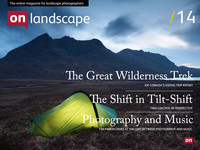Is there a connection?

Tim Parkin
Amateur Photographer who plays with big cameras and film when in between digital photographs.
If you’ve read around the outskirts of photography for while, you can’t help but have come across the occasional use of music as a metaphor for some part or other of the photographic process. Whether you have or not, I’m hoping this article will give you a bit more to think about.
The most famous analogy between these two is Ansel Adams’ metaphor “The negative is comparable to the composer's score and the print to its performance”. Ansel’s use of music as a metaphor is all the more apposite as he was a concert pianist, nearly choosing music over photography at one point.
Straw polling quite a few colleagues and other photographers shows many have a musical bent too, David Clapp (guitar), Melanie Foster (saxaphone), Richard Childs (drums), Charles Cramer (piano), me (guitar - somewhat badly), Dav Thomas (guitar), etc. and I have a theory why.. bear with me whilst I go on a trip through pyschology.
WARNING - emotive subject being discussed. I'm not getting into analysing clinical autism here. Just want to discuss some observations around the subject!
There is a sliding scale on which we all appear called ‘autistic spectrum disorders’. I have a little personal beef with this because if it’s a scale and we all live on it, how can it be a disorder? Anyway, my point is that as we exhibit some aspects of this ‘disorder’ we pass through an area that is referred to as ‘aspergers’. People who work with computers, scientists and musicians quite often exhibit far greater than average incidence of Aspergers syndrome. The psychological profile extends to artists also, there is great book on this subject “The Genesis of Artistic Creativity: Asperger's Syndrome and the Arts, by Michael Fitzgerald, Paperback, ISBN: 9781843103349”. It has been suggested by many that Michaelangleo, Newton, Einstein, Darwin and Wittgenstein were all ‘sufferers’ of Aspergers (obviously these are retrospective diagnoses based on biographical analysis). My suggestion is that landscape photography has a correlation with this 'syndrome'.
So why would this condition have such a strong link with photography (art) and music? Well one of the key aspects of both of these is to do with the recognition and creation of patterns. A major aspect of the creation of music is the structuring of ‘data’ into ordered patterns. Photographic composition is also founded on the creation of order out of ‘chaos’; on the identification of patterns and structure and the organisation of components into a coherent whole (or incoherent depending on your propensity for Schonberg).
Part of our evolution has been to find these patterns in order to survive. The issue is that it seems that being better at seeing patterns means that you are potentially worse at social interaction (note this doesn't mean *bad*, just that it doesn't come naturally - you won't tend to be or enjoy being a professional salesman if you fit into the 'Aspergers' symptoms). So landscape photography is ideal - none of that making small talk - just a person and his camera looking for order in the chaos of the wilderness.
Beyond Ansel’s analogy, music can be a useful metaphor for many other aspects of photography. Let’s take a look at musical tastes. Everybody has incredibly different musical tastes and an open minded jazz fan can enjoy a great indie track as much as an indie fan can get into Canon in D (if they can get past ‘Altogether Now’).
Why is it we can accept the range of different music tastes that we all have but we find it difficult to realise that the same is true of photography? We don’t have to have universal acclaim to have merit; In fact in terms of indie music, bands become less cool as they become more popular.
Perhaps there is also a parallel between the success of local cover version pub bands over original music - I’ll leave the conclusions to our readers.
In terms of music structure, the classic progression of dissonance to resolution has it’s potential in photography too. The ii V I progression is typically a more interesting turnaround than a simple continuous maj7 - and in photographic terms, the question would be “Can I create a more pleasing final result through the inclusion of dissonance than in the straightforward application of beauty?”. To me, I would say yes - it’s the dissonances in a picture that keep your eye moving around, the inclusion of ‘tensions’ that keep a viewer looking. (This could be taken to another step when putting together a series of photographs such as in an exhibition or book).
I have a few other ideas mulling around in my mind and I may add to this later... in the meantime, please let me know what you think and if you can come up with any other connections.

